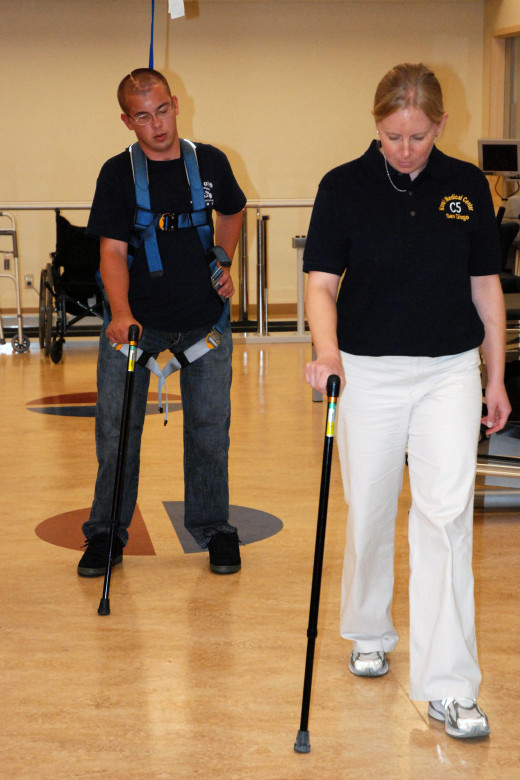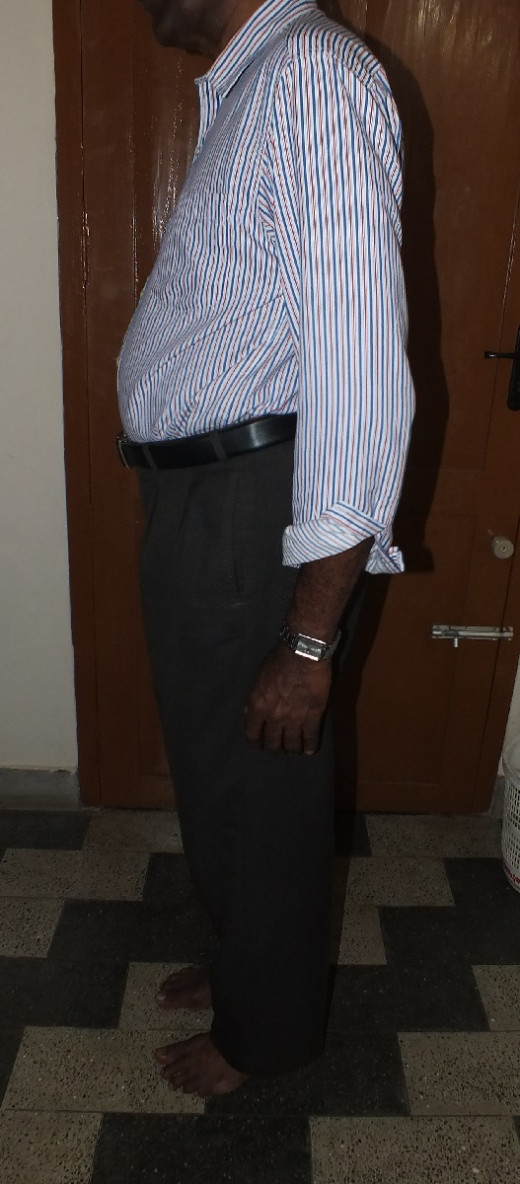Gait Training – Weight Bearing & Shifting Exercises - Physiotherapy Management #2


Introduction
Once the patient has attained the standing balance, we can proceed to Weight Shifting Exercises.
The exercises from 1 to 5 is better done in between parallel bars with footprints marked on the floor. A long vertical mirror may be placed in front of the parallel bars so that the patient may watch and adjust his footsteps accordingly.
Parallel bars can be made at home using branches of trees or bamboo. A design for hostpital use is shown in the figure. This is made of metal rods.


1. Sideways Walking Exercise
The patient stands relaxed with the feet 4-6 inches apart with the hands hanging down. He sways the body towards the left so that the body weight is fully transferred to the left lower limb. Now the right lower limb is free and can be moved. Hence the right lower limb is lifted up from the ground and is placed about 12 inches towards the right. Now sway the body towards right so that the body weight is fully transferred to the right lower limb. Now the left lower limb is free to move. Hence the left lower limb is lifted up from the ground and is placed close to the right lower limb. In this way 10 steps are taken in one stretch towards right. Now rest for 5-10 seconds. Do the same exercise towards the left side also. The size of the steps taken may be varied i.e. increased or decreased, taking into consideration the convenience of the patient. The presence of the physiotherapist is essential while doing the exercise and he must support or help him, if necessary.


2. Forward Walking Exercise.
The patient stands relaxed with the feet 4-6 inches apart with the hands hanging down. He sways the body towards the left side so that the body weight is transferred to the left lower limb. Now the right lower limb is free to move. Hence the right lower limb is lifted from the ground and is placed about 15 inches forward with a base width of approximately 2-4 inches (this is because the normal step length between the two heels is approximately 15 inches and the normal base width is 2-4 inches). Now sway the body forward so that the whole body weight is transferred to the right lower limb which is kept in front. Now the left lower limb is free to move. Hence the left lower limb is lifted up from the ground and is brought forward and is placed near the right lower limb. In this way 10 steps are taken in one stretch in the forward direction. Now rest for 5-10 seconds. Do the exercise in the backward direction also. The size of the steps may be varied i.e. increased or decreased, taking into consideration the convenience of the patient. The presence of the physiotherapist is essential while doing the exercise and he must support or help him, if necessary.
The same exercise can also be done in the other way round with the left lower limb moving initially and the right lower limb following on.


3. Forward Walking Exercise –Normal Gait
The patient stands relaxed with the feet 4-6 inches apart with the hands hanging down. He sways the body towards left side so that the body weight is transferred to the left lower limb. Now the right lower limb is free to move. Hence the right lower limb is lifted up from the ground and is placed about 15 inches forward with a base width of approximately 2-4 inches (this is because the normal step length between the two heels is approximately 15 inches and the normal base width is approximately 2-4 inches). Now sway the body forward so that the whole body weight is transferred to the right lower limb which is kept in front. Now the left lower limb is free to move. Hence the left lower limb is lifted up from the ground and is brought forward and is placed in front of the right lower limb (the heel of the left lower limb is approximately in line with the big toe of the right lower limb) with a base width of approximately 2-4 inches, as in the case of normal gait. Swing the body forward and backward so that the body weight is transferred to both the lower limbs alternately. This swing movement is done 5 times in one stretch. Now sway the body forward so that the body weight is transferred to the left lower limb. Now the right lower limb is free to move. Hence the right lower limb is lifted up from the ground and is brought forward and is placed in front of the left lower limb(the heel of the right lower limb is approximately in line with the big toe of the left lower limb) about with 4 inches base width, as in the case of normal gait. Swing the body forward and backward so that the body weight is transferred to both the lower limbs alternately. This swing movement is done 5 times in one stretch. In this way 10 steps are taken in one stretch in the forward direction. Now rest for 5 seconds. Do the exercise in the backward direction also. The size of the steps may be varied i.e. increased or decreased, taking into consideration the convenience of the patient. The presence of the physiotherapist is essential while doing the exercise and he must support or help him, if necessary.

4. Walking on Toes Exercise
The patient stands relaxed with the feet 4-6 inches apart with the hands hanging down. Now the patient stands on the toes. He walks forward on toes. 10 steps are taken in one stretch in the forward direction. Now rest for 5 seconds. Do the exercise in the backward direction also. The size of the steps may be varied i.e. increased or decreased, taking into consideration the convenience of the patient. While walking on the toes there is every possibility that the patient may lose balance and falling down. Hence Walking on Toes Exercise may be given near a wall so that he can touch the wall with one or both hands and maintain the balance. The presence of the physiotherapist is essential while doing the exercise and he must support or help him, if necessary.

5. Walking on Heels Exercise
The patient stands relaxed with the feet 4-6 inches apart with the hands hanging down. Now the patient stands on the heels. He walks forward on heels. 10 steps are taken in one stretch in the forward direction. Now rest for 5 seconds. Do the exercise in the backward direction also. The size of the steps may be varied i.e. increased or decreased, taking into consideration the convenience of the patient. While walking on the heels there is every possibility that the patient may lose balance and falling down. Hence Walking on Heels Exercise may be given near a wall so that he can touch the wall with one or both hands and maintain the balance. The presence of the physiotherapist is essential while doing the exercise and he may support or help him, if necessary.


6. Walking Up and Down the Stairs
The patient stands relaxed with the feet 4-6 inches apart with the hands hanging down, facing the stairs. He sways the body towards left side so that the body weight is transferred to the left lower limb. Now the right limb is free to move. Now the right limb is lifted up from the ground and is placed on the first step. He gradually lifts the body up by straightening the right lower limb which is on the first step and then places the left lower limb on the first step itself near the right lower limb. Thus the patent climbs up the stairs by one step at a time. To start with, the patient may climb up the stairs with support on the railings and later without support progressively. In this way, 5 steps are taken in one stretch in the upward direction. Now rest for 5-10 seconds. Do the exercise in the downward direction also. The presence of the physiotherapist is essential while doing the exercise and he may support or help him, if necessary.
This exercise can also be done in the other way round with the left lower limb moving initially and the right lower limb following on.
If one lower limb is weak, the step may be climbed up with the normal lower limb rather than with the weak one. But while climbing down the stairs, the weak limb is preferred to climb down rather than the normal one.

7. Walking Up and Down the Stairs –Normal Gait
The patient stands relaxed with the feet 4-6 inches apart with the hands hanging down, facing the stairs. He sways the body towards left side so that the weight is transferred to the left lower limb. Now the right lower limb is free to move. Now the right lower limb lifted up from the ground and is placed on the first step. He gradually lifts the body up by straightening the right lower limb which is on the first step and places the left lower limb on the second step i.e. he climbs up the stairs placing one foot on each step. Thus the patient climbs up the stairs as in normal gait. To start with, the patient may climb up the stairs with support on the railings and later without support progressively. In this way 5 steps are taken in one stretch in the upward direction. Now rest for 5-10 seconds. Do the exercise in the downward direction also. The presence of the physiotherapist is essential and he may support or help him, if necessary.
This exercise may also be done in the other way round with the left lower limb moving initially and the right lower limb following on.
If one lower limb is weak, the step may be climbed up with the normal limb rather than with the weak one. But whiling climbing down the stairs, the weak limb is preferred to climb down rather than the normal one.
How to stand up from sitting posture, vice versa
The patient slides forward so that he sits almost at the edge of the chair. The patient draws his knees under the chair. He bends his trunk forward so that the center of gravity falls in front. Now he gets up from the chair extending the hips and knees.
When he sits on the chair from standing position, the above process is reversed.








